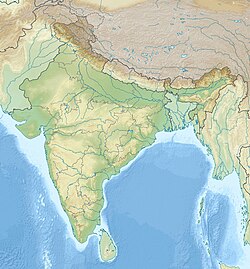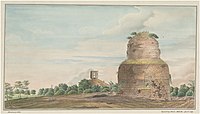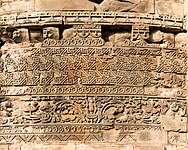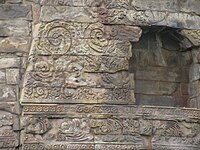Dhamek Stupa
| Dhamek Stupa धामेक स्तूप (in Hindi) | |
|---|---|
 | |
| Religion | |
| Affiliation | Buddhism |
| Status | Preserved |
| Location | |
| Location | |
| Administration | Archaeological Survey of India |
| Geographic coordinates | 25°22′51″N 83°01′28″E / 25.3808°N 83.0245°E |
| Architecture | |
| Type | Stupa |
| Style | Buddhist, Gupta |
| Completed | 500 CE |
| Specifications | |
| Length | 28 metres (92 feet)[1] |
| Width | 28 metres (92 feet)[1] |
| Height (max) | 43 metres (141 feet)[1] |
| Materials | white makrana marble |
The Dhamek Stupa (also spelled Dhamekh and Dhamekha, traced to Sanskrit version Dharmarajika Stupa, which can be translated as the Stupa of the reign of Dharma) is a massive stupa located at Sarnath in the state of Uttar Pradesh, India.[2] The Dhamek Stupa marks the precise location where the Buddha preached his first discourse to his first five disciples (Kaundinya, Assaji, Bhaddiya, Vappa and Mahanama), and where all five eventually became fully liberated.[3]
Location

Dhamek Stupa is located in Sarnath, 12 kilometres (7.5 miles) to the northeast of Varanasi, in Uttar Pradesh, India.
Description
Dhamek Stupa is the most massive structure in Sarnath.[4] In its current shape, the stupa is a solid cylinder of bricks and stone reaching a height of 43.6 meters and having a diameter of 28 meters. The basement seems to have survived from Ashoka's structure, while the stone facing displays delicate floral carvings characteristic of the Gupta era. The wall is covered with exquisitely carved figures of humans and birds, as well as inscriptions in Brahmi script.[5] The stupa was enlarged on six occasions but the upper part is still unfinished.[6] While visiting Sarnath in 640 CE, Xuanzang recorded that the colony had over 1,500 priests and the main stupa was nearly 300 feet (91 m) high.[7]
An Ashoka pillar with an edict engraved on it stands near the site.
History
The Dhamek Stupa marks the precise location where the Buddha preached his first discourse to his first five disciples (Kaundinya, Assaji, Bhaddiya, Vappa and Mahanama), and where all five eventually became fully liberated.[3] This event marked the formation of the sangha. Several of the ancient sources describe the site of this first sermon as a Mriga-dayaa-vanam or a sanctuary for animals. (In Sanskrit, the word mriga is used in the sense of game animals, with deer being the most common).
After the parinirvana of the Buddha in 544 BCE, his remains were cremated and the ashes were divided and buried under eight stupas, with two further stupas encasing the urn and the embers. The Dhamek Stupa was presumably among these eight stupas. In 249 BCE, Mauryan King Ashoka commissioned the expansion of the Dhamek Stupa.[8] The Dhamek Stupa was further expanded in 500 CE.[9]
The earliest mention[10] of the ruins at Sarnath in modern literature was by Jonathan Duncan. Duncan described the discovery in January 1794 of a stone reliquary by employees of Babu Jagat Singh (Diwan of Raja Chet Singh of Banaras).[11][12]
Gallery
-
Dhamek Stupa, a watercolour by Abdullah, Shaikh, 1819
-
Dhamekh Stupa
-
History of Dhamekh Stupa
-
Dhamekh Stupa close-up
-
Dhamekh Stupa wall close-up
-
Sarnath - Plan of Excavations
References
- ^ a b c "Sarnath attractions that you shouldn't skip". The Times of India.
- ^ "Dhamekh Stupa Sarnath, Varanasi India". iloveindia.com.
- ^ a b "Historical Places of the Buddha |". Igatpuri, Maharashtra, India: Vipassana Research Institute. Retrieved 13 December 2022.
- ^ "Dhamekh Stupa". Varanasicity.com. Retrieved 16 October 2006.
- ^ "Dhamekh Stupa". Retrieved 19 September 2006.
- ^ Bradnock, Robert W. Footprint India. Footprint Travel Guides, 2004. ISBN 1-904777-00-7. Page 191.
- ^ Arnett, Robert A. India Unveiled. Atman Press, 2006. ISBN 0-9652900-4-2.
- ^ "Stupas". Indian Heritage. Archived from the original on 8 January 2007. Retrieved 20 November 2006.
- ^ Sir Banister Fletcher's a History of Architecture, 20th ed. (ed. by Dan Cruickshank). Architectural Press, 1996. ISBN 0-7506-2267-9. Page 646.
- ^ Cunningham, Alexander (1871). Four reports made during the years 1862-63-64-65. Vol. 1. Shimla, Himachal Pradesh, India: Archaeological Survey of India. pp. 103–30.
- ^ Duncan, Johnathan (1799). "An Account of the Discovery of Two Urns in the Vicinity of Benares". Transactions of the Society Instituted in Bengal, for enquiring into the History and Antiquities, the Arts, Sciences and Literature, of Asia. 5: 131–2.
- ^ "Buddhist Trails in Sarnath". Explore Varanasi. Varanasi, Uttar Pradesh, India: incrediblevaranasi.com. 21 August 2018. Retrieved 13 December 2022.








